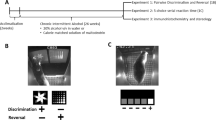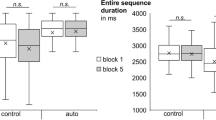Abstract
It has previously been reported that prior administration of naloxone may prevent the decrement in performance produced by alcohol. To be of clinical value, however, naloxone must be shown to reverse rather than prevent this decrement. This study examined the effect of naloxone given after consumption of alcohol. A double blind balanced crossover protocol was used to examine the effect of either 1.2 mg or 10 mg naloxone on the sensory-motor impairment produced by blood alcohol concentrations maintained between 75 and 85 mg/100 ml. This alcohol concentration significantly impaired two measures of sensory-motor performance, but there was no evidence that either dose of naloxone could reverse this decrement. We tested our subjects for a chlorpropamide alcohol flush but none gave a positive response. These results indicate that naloxone (1.2 mg or 10 mg) does not reverse the sensory-motor impairment produced by alcohol intoxication in subjects who do not exhibit a chlorpropamide alcohol flush. Nearly all the subjects exhibited somnolence after receiving alcohol and naloxone (1.2 mg or 10 mg) but not after receiving alcohol and saline.
Similar content being viewed by others
References
Frith CD (1973) Learning rhythmic hand movements. Q J Exp Psychol 25:253–259
Frith CD, Lang RJ (1979) Learning and reminiscence as a function of target predictability in a two-dimensional tracking task. Q J Exp Psychol 31:103–109
Jasinski DR, Martin WR, Haertzen CA (1967) The human pharmacology and abuse potential of n-allynoroxymorphone (naloxone). J Pharmacol Exp Ther 157:420–426
Jeffcoate WJ, Herbert M, Cullen MH, Hastings AG, Walder CP (1979) Prevention of effects of alcohol intoxication by naloxone. Lancet II: 1157–1159
Jefferys DB, Flanagan RJ, Volans CJ (1980) Reversal of ethanol induced coma with naloxone. Lancet I:308–309
Jordan C, Lehane JR, Jones JG (1980) Respiratory depression following diazepam; reversal with high dose naloxone. Anesthesiology 53:293–298
Leslie RDG, Pyke DA (1978) Chlorpropamide-alcohol flushing: adominantly inherited trait associated with diabetes. Br Med J 2:1519–1521
Mackenzie AI (1979) Naloxone in alcohol intoxication. Lancet II:733–734
Mendelson JH, Albeck J (1977) Naloxone modification of acute alcohol intoxication in humans. In: Problems of drug dependence. Proc. 39th Ann. Sci. Meeting, Committee on Problems of Drug Dependence; Cambridge, Mass., pp 572–582
Ross DH (1976) Selective action of alcohols on cerebral calcium levels. Ann N Y Acad Sci 273:280–293
Ross DH, Medina MA, Lee Cardenas H (1974) Morphine and ethanol: selective depletion of regional brain calcium. Science 186:63–65
Sorensen SC, Mattison KD (1978) Naloxone as an antagonist in severe alcoholic intoxication. Lancet II:688–689
Wright BM (1971) A simple mechanical ataxia-meter. J Physiol (Lond) 218:27–28P
Author information
Authors and Affiliations
Rights and permissions
About this article
Cite this article
Catley, D.M., Jordan, C., Frith, C.D. et al. Alcohol induced discoordination is not reversed by naloxone. Psychopharmacology 75, 65–68 (1981). https://doi.org/10.1007/BF00433504
Received:
Accepted:
Issue Date:
DOI: https://doi.org/10.1007/BF00433504




